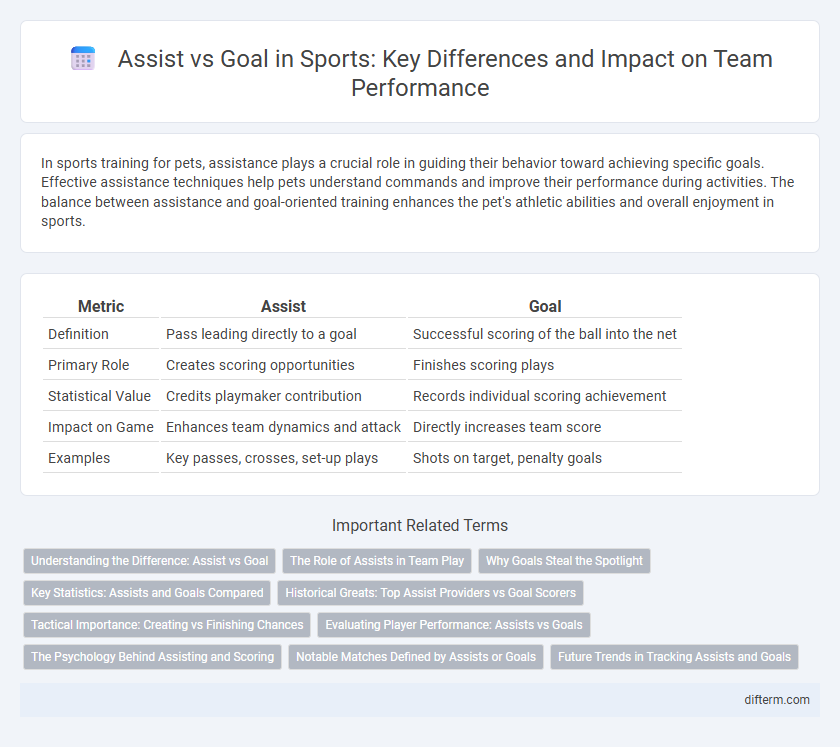In sports training for pets, assistance plays a crucial role in guiding their behavior toward achieving specific goals. Effective assistance techniques help pets understand commands and improve their performance during activities. The balance between assistance and goal-oriented training enhances the pet's athletic abilities and overall enjoyment in sports.
Table of Comparison
| Metric | Assist | Goal |
|---|---|---|
| Definition | Pass leading directly to a goal | Successful scoring of the ball into the net |
| Primary Role | Creates scoring opportunities | Finishes scoring plays |
| Statistical Value | Credits playmaker contribution | Records individual scoring achievement |
| Impact on Game | Enhances team dynamics and attack | Directly increases team score |
| Examples | Key passes, crosses, set-up plays | Shots on target, penalty goals |
Understanding the Difference: Assist vs Goal
An assist in sports, particularly in soccer and basketball, is the final pass or action leading directly to a teammate scoring a goal. A goal is the successful act of putting the ball into the net, resulting in points for the team. Understanding the difference is essential for analyzing player contributions and overall team performance.
The Role of Assists in Team Play
Assists play a crucial role in team play by facilitating goal-scoring opportunities and enhancing overall offensive coordination. Players with high assist counts, such as top midfielders, are pivotal in creating space, delivering precise passes, and maintaining possession, directly contributing to a team's success. Effective assist strategies improve scoring efficiency and foster collaborative dynamics, often leading to higher win rates.
Why Goals Steal the Spotlight
Goals steal the spotlight because they directly determine the outcome of a match, making them the most celebrated moments in sports like football and hockey. While assists are critical for creating scoring opportunities, goals provide the definitive result that fans and commentators remember. The clear impact of goals on the scoreboard elevates their importance above assists in both player recognition and game analysis.
Key Statistics: Assists and Goals Compared
In soccer, goals are the primary measure of a player's scoring ability, while assists highlight playmaking skills by setting up goal-scoring opportunities; top strikers often combine high goal tallies with significant assist counts, reflecting their dual threat on offense. Statistical analysis shows players with more than 10 assists per season typically create over 30% of their team's chances, correlating strongly with overall team success and offensive efficiency. Tracking assists alongside goals provides a comprehensive evaluation of player impact, revealing those who contribute both in finishing and creating pivotal scoring moments.
Historical Greats: Top Assist Providers vs Goal Scorers
Historical greats in sports are often defined by their contributions as top assist providers or prolific goal scorers, with players like Lionel Messi excelling in both categories by delivering over 300 assists and scoring more than 700 goals in official matches. Assist leaders such as Xavi Hernandez revolutionized playmaking by consistently setting up teammates, resulting in record-breaking assist counts that highlight their vision and teamwork. Goal scorers like Cristiano Ronaldo have etched their names in history with unmatched goal tallies, exceeding 800 career goals across club and international competitions, underlining the critical role of finishing in sports success.
Tactical Importance: Creating vs Finishing Chances
Assists represent the tactical skill of creating scoring opportunities through precise passing and vision, often dictating the team's attacking flow and unlocking defenses. Goals demonstrate the ability to finish chances with accuracy, composure, and timing, directly influencing the scoreboard and match outcomes. Both creating assists and scoring goals are essential for effective offensive strategies and overall team success.
Evaluating Player Performance: Assists vs Goals
Evaluating player performance in sports hinges on analyzing both assists and goals, as each metric highlights different skill sets: goals demonstrate finishing ability and scoring efficiency, while assists underscore playmaking and vision on the field. Advanced statistics like expected assists (xA) and expected goals (xG) provide deeper insights into a player's contribution beyond traditional counting stats. Balancing these metrics helps coaches and analysts identify well-rounded players who influence game outcomes through both goal creation and scoring.
The Psychology Behind Assisting and Scoring
Assisting in sports requires acute awareness and anticipation, emphasizing teamwork and the ability to predict teammates' movements, which fosters a sense of collaboration and shared success. Scoring, on the other hand, demands confidence, decisiveness, and mental resilience to seize critical opportunities under pressure, highlighting individual achievement and competitive drive. The psychology behind assisting and scoring reflects a balance between altruism and ambition, shaping player motivation and overall team dynamics.
Notable Matches Defined by Assists or Goals
Notable matches often hinge on the balance between assists and goals, where players like Lionel Messi and Kevin De Bruyne have revolutionized game dynamics through precise assists that lead directly to scoring opportunities. The 2010 FIFA World Cup final showcased Andres Iniesta's crucial assist before netting the winning goal, highlighting how assists and goals together define match outcomes. Historic games such as the 2005 UEFA Champions League final also emphasize the significance of pivotal assists, as Steven Gerrard's playmaking directly influenced the dramatic comeback and eventual victory.
Future Trends in Tracking Assists and Goals
Advanced tracking technologies are revolutionizing the analysis of assists and goals by providing detailed player movement and positional data in real time. Machine learning algorithms predict assist potential and goal likelihood by analyzing spatial patterns and player behavior during matches. Integrating wearable sensors and AI-driven video analytics will enable more accurate, context-rich statistics, enhancing tactical decisions and fan engagement in future sports environments.
assist vs goal Infographic

 difterm.com
difterm.com